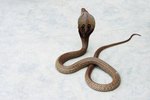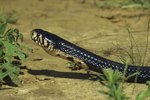
King cobras (Ophiophagus hannah) are the longest venomous snakes in the world. Specimens can exceed 16 feet long, although just under 10 feet is more realistic. They are infamous for their aggressive behavior, which most typically arises when they are disturbed, feel threatened or suspect a threat to their young; for their penchant for eating other snakes and for their intimidating, haunting sway displays. Fortunately for most of the world, these terrifying and deadly snakes are native to only one continent.
The King Cobra’s Home
While they live in captivity around the world, king cobras are native to Asia, particularly China, India, Bangladesh, Myanmar, Cambodia, Laos, Thailand, Vietnam, Malaysia, Indonesia and the Philippines. King cobras are primarily forest dwellers, but they may also be found in mangrove, swamps, paddy fields, corn fields and even human settlements. They are quite happy at a range of elevations, from sea level up to 6,500 feet in the hills and mountains that decorate the Asian landscape.
Culture Clash
In parts of India and southeast Asia, the cobra is considered to be godlike. Legend has it that the king cobra controls rain, thunder and fertility. Snake charmers are admired for their ability to control the snake. In some traditions, a kiss to the king cobra’s head is thought to bring plentiful harvests and fertility to the woman who delivers the embrace. Another myth claims that only 100 people may cast eyes on a king cobra; any more and he will die. It says that only king cobras who are ready to pass on to the next life will enter settlements so they can be viewed by more than 100.
A Disappearing Legend
The king cobra is considered vulnerable, according to the Convention on International Trade in Endangered Species. The main threat to his survival is deforestation, a booming industry in India and China. With deforestation comes habitat destruction, which limits places to hunt, breed and live. Humans used to revere and respect the deadly king cobra but are growing less tolerant of this legendary beast. While once they would do their best to avoid the snake, now they are more likely to kill them, and they attempt to control the snake's numbers.
How Deadly
Human fatalities from snake bites are growing, especially in Asia. Despite the reverence he enjoys, the king cobra is deadly. He has enough venom in one bite to kill an adult elephant or up to 30 adults. This capacity for killing, combined with his reluctance to back down, is why locals are now more interested in killing, than revering the king cobra. When disturbed, feeling threatened or, if she's female, suspecting a threat to young, a king cobra will adopt an aggressive posture and "growl" loudly.
References
Photo Credits
-
Tom Brakefield/Stockbyte/Getty Images
Writer Bio
Simon Foden has been a freelance writer and editor since 1999. He began his writing career after graduating with a Bachelors of Arts degree in music from Salford University. He has contributed to and written for various magazines including "K9 Magazine" and "Pet Friendly Magazine." He has also written for Dogmagazine.net.



